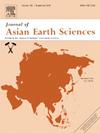Origin of chromitites and dunites of the Dazhuqu ophiolite in the Yarlung-Zangbo ophiolite zone, Tibet
IF 2.7
3区 地球科学
Q2 GEOSCIENCES, MULTIDISCIPLINARY
引用次数: 0
Abstract
The origin of chromitites in ophiolites remains a topic of debate. The Dazhuqu ophiolitic massif located in the central segment of the Yarlung-Zangbo ophiolite zone contains podiform chromitites. The massive chromitites exhibit significantly low Cr# (38–47) in chromite. In contrast, the disseminated chromitites have relatively wide range of Cr# (16–64) in chromite. The dunites can be classified into two group: low-Cr# chromite-bearing dunites (Cr# = 19–51) and high-Cr# chromite-bearing dunites (Cr# = 74–83). The chromite of harzburgites show similar Cr# range (27–55) to that of the disseminated chromitites and low-Cr# chromite-bearing dunites. The negative correlation between Ti and Cr# along with the positive correlation between Ni and Mg# in chromite suggests that the massive chromitites formed through the physical sorting and accumulation of chromite grains in the melt conduits. The compositional patterns of chromite in the disseminated chromitites and low-Cr# chromite-bearing dunites resemble those of the harzburgites, implying that their chromite may have inherited compositional signatures from the surrounding harzburgites. In contrast, the chromite in the high-Cr# chromite-bearing dunites exhibits compositional patterns associated with boninitic melts. The coexistence of the chromitites and dunites with lower Cr# of chromite and high-Cr# chromite-bearing dunites indicate that the Dazhuqu massif was once modified by both MORB-like and boninitic melts, causing highly variable Cr# of chromite. A model of subduction initiation accounts for the magmatic evolutionary history of the chromitites and mantle sequence of the Dazhuqu massif.

求助全文
约1分钟内获得全文
求助全文
来源期刊

Journal of Asian Earth Sciences
地学-地球科学综合
CiteScore
5.90
自引率
10.00%
发文量
324
审稿时长
71 days
期刊介绍:
Journal of Asian Earth Sciences has an open access mirror journal Journal of Asian Earth Sciences: X, sharing the same aims and scope, editorial team, submission system and rigorous peer review.
The Journal of Asian Earth Sciences is an international interdisciplinary journal devoted to all aspects of research related to the solid Earth Sciences of Asia. The Journal publishes high quality, peer-reviewed scientific papers on the regional geology, tectonics, geochemistry and geophysics of Asia. It will be devoted primarily to research papers but short communications relating to new developments of broad interest, reviews and book reviews will also be included. Papers must have international appeal and should present work of more than local significance.
The scope includes deep processes of the Asian continent and its adjacent oceans; seismology and earthquakes; orogeny, magmatism, metamorphism and volcanism; growth, deformation and destruction of the Asian crust; crust-mantle interaction; evolution of life (early life, biostratigraphy, biogeography and mass-extinction); fluids, fluxes and reservoirs of mineral and energy resources; surface processes (weathering, erosion, transport and deposition of sediments) and resulting geomorphology; and the response of the Earth to global climate change as viewed within the Asian continent and surrounding oceans.
 求助内容:
求助内容: 应助结果提醒方式:
应助结果提醒方式:


